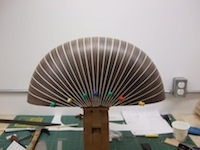I often decide to use a rose design other than the one that appears on the original of the model that I am building. This is the third Kaiser theorbo that I have built in the last 12 months and for this one I decided to borrow the triple rose that is cut into the belly of a theorbo by Pietro Railich. On the right is the original 17th century Railich rose. I examined this lute several years ago and wrote a story about this lute for my website. You can see it at:
http://www.schreinerlutes.com/projects.html
This is a fairly open design that would look too simple if it were reproduced in a larger format, such as a single rose on the face of a lute, but here the appearance is lacy and elegant because of its small size. The diameter of each of the larger pair of roses only measure 68 mm. The smaller, single rose is 61 mm. The design is composed of two smaller concentric circles inside the larger diameter of the entire design. A series of repeating arcs based on the division of the whole into sixteen parts fills out the design. The leaf and bud motif gives it an organic touch.
I drew the design about 50% larger than size that I would need in order gauge the thickness of the individual elements. Then I reduced copies of it to the size that I needed on a photocopier.
Once I had the rose pattern finished I still wasn't ready to begin carving. Triple roses are usually laid out so that the decorative surrounding rings inter-connect. This takes some careful calculation and adjustment of the compass. You can appreciate the exactness that is necessary in the closeup photo of my finished rose. Note too, that there is no marks in the center of the roses from the compass point. Many surviving historical lutes show thee blemishes. I wanted to avoid them. The center photo demonstrates my technique.
The trammel point of the circle cutter rests in a tiny hole that I drilled into, but not through, a small scrape of ebony that I "tack" glued to the soundboard. This way I was able to draw the inter-locking decorative circles with a compass first to make sure that everything lined up. Then I was able to confidently score them with the circle cutter. The ebony blocks, after serving their purpose, are removed by touching them with a hot iron for a few seconds. This melts and releases the glue.
The last photo shows that I am well under way. I have finished scoring the interlocking rings, glued the small rose pattern in place and done some rose carving. Next time I'll talk about the tools, explain some carving techniques and talk about the ever present problems and pitfalls.






















